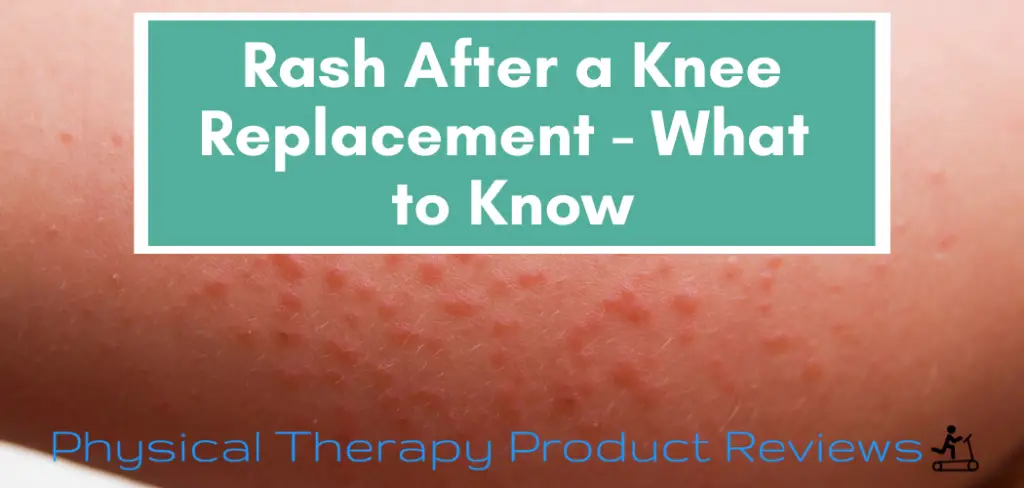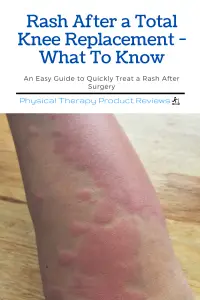 One of the more common issues that we see after a Total Knee Replacement is a rash that can develop after surgery. Even though this can be scary, most of the time, it’s easily treated with at home with emergency medical attention. So if you are reading this on the way to the E.R., don’t panic just yet!
One of the more common issues that we see after a Total Knee Replacement is a rash that can develop after surgery. Even though this can be scary, most of the time, it’s easily treated with at home with emergency medical attention. So if you are reading this on the way to the E.R., don’t panic just yet!
Developing a rash after a knee replacement is more common than you might think with rates between 20-38% depending on the cause of the rash. In this article, we hope to help understand the difference between a rash and a knee infection, educate how to treat the rash quickly, and when you should seek further medical care.
Rash After a Knee Replacement - What's Normal?
A rash after a knee replacement looks like most other rashes you’ve had in the past. You can expect to see skin redness, potential red bumps, and overall suffering through the feeling of irritated skin which includes:
- Itchiness
- Raised Bumps
- Burning
- Dry skin
- Mild swelling
- Increased warmth.
Here is a sample of a rash two weeks after a knee replacement.
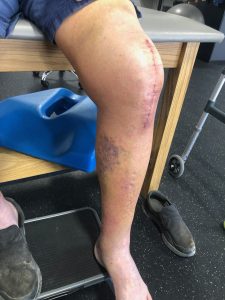
Knee Infection vs. Dermatitis Rash
Skin redness and irritation are always alarming to the person experiencing them and can be caused by many different things, including a knee infection. A knee infection is a serious issue and should be addressed immediately with medical attention. Here is a table comparing a knee infection with a common rash.
| Knee Infection | Rash |
|---|---|
| Redness, Tenderness, Warmth, and Swelling | Raised itching bumps, redness, and swelling |
| Fever over 100 degrees F | Slight Fever |
| Chills and body aches | May be on multiple areas of the body or localized |
| Colored drainage that has an odor AT THE SURGICAL SITE | Drainage in areas of scratching and itching |
| Swelling predominately located around the surgical sight | Potential blood blisters near the site of contact |
How to Treat a Rash After Knee Surgery
The first thing to do is to remain calm. Most rashes, even after surgery, can be easily treated and are not signs of a severe medical issue. Here are the next important steps you need to do if you have a rash.
Take Off or Remove Anything in Contact with the Rash
Most rashes are caused by contact with an object that causes an allergic reaction. Immediately remove anything in the area that could be irritating such as metal objects, adhesives, or any new clothing.
Review Any New Medications You Recently Started
If the rash is on multiple parts of the body then it’s likely that your body is having an allergic reaction to a new medication. Some medications such as pain pills, antibiotics, or anti-inflammatories may cause a systemic allergic reaction. Discontinue the medication if its not a life saving drug and call your doctor for other options.
Mark the Ends or Trace the Area with a Marker
You and the medical team will want to know if the rash is getting worse. The best way to track the progress is to take a picture and then mark the ends of the rash with a permanent marker.
Take a Picture with Your Cell Phone
It’s important to take a picture with your cell phone. The physician or physical therapist may want you to send a picture of the rash to track its progress.
Take Benedryl or Another Antihistamine
Benedryl is an antihistamine that helps with allergic reactions, including rashes. Follow the instructions and take only the recommended amount until the rash is nearly gone.
Be cautious as Benedryl can make you sleepy, and combines with other medications that cause drowsiness, could be problematic with driving.
Try a Topical Steroid Cream
While Benedryl is attacking the rash from the inside, the topical corticosteroid cream will treat it on the outside. Over-the-counter topical creams such as Cortizone-10 will help relieve the itching and tenderness on the skin.
Continue to Do Your Exercises
Exercise can help reduce stress hormones and promote blood flow, which both can help with any new rashes. It’s essential to continue with your knee range of motion exercises so that your knee does not tighten up while it has extra swelling and soreness from the rash.
Let Your Medical Providers Know
It’s always best to let your medical providers know about the rash. Call and let your surgeon’s office know and offer to send pictures from your cell phone. They may still have you come in just to be safe.
Your Physical Therapist may want to get you in the next day to make sure it is indeed a rash and not a knee infection.
Causes of Rashes after a Knee Replacement
The most common types of rashes are allergic reactions to adhesives in the bandages and steristrips. This is called Contact Dermatitis. This is the likely cause if the rash is localized.
If the rash is on multiple body parts and not near any new surgical sites or bandages then it is likely a reaction to a medication.
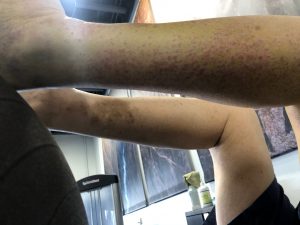
Other causes of rashes after a total knee replacement include:
- Reactions the compression stockings
- A systemic allergic reaction to food or drink (especially if it’s in more than one body part)
- Reaction to new soap (especially if showering in a different bathroom)
- Response to metal in the prosthesis
- Reaction to the topical pain cream used at home or therapy
What is Contact Dermatitis
Contact dermatitis is a skin irritation caused by direct contact with a surface or object that causes an allergic reaction. The rash includes red and raised skin that is irritated and sometimes itchy. Dermatitis is not contagious or life-threatening. However, it can be alarming and uncomfortable to the patient.
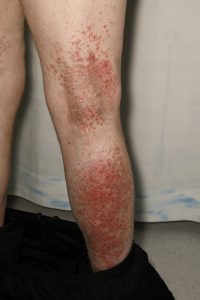
When to Seek Emergency Medical Care for a Rash
Most of the time, rashes and dermatitis are not a medical emergency, but it’s good to know when you should be concerned and seek immediate medical care. Here are symptoms that should warrant a trip to the ER in addition to a rash.
- Difficulty breathing that is not relieved with Benedryl
- Increasing fever and body temperature that is unchanged with medication
- Unrelenting body aches that do not change with position
- Severe drainage or oozing from the surgical site
- No symptoms relief with over the counter medication
What Does a Metal Allergy Look Like After Surgery?
A metal allergy looks similar to any other common allergic reaction. The result is skin irritation with redness, swelling, itching, a rash, or even potential blisters in severe reactions.
A metal allergy may be present in the area near the staples in a total knee replacement, or you may see a reaction in the entire leg. If you have itching, redness, and swelling that any other causes can’t explain, you can request to be tested for a metal allergy.
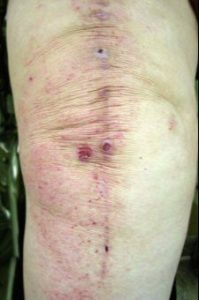
FAQ About Rashes with Total Knee Replacement
How Common is a Metal Allergy?
A metal allergy in patients with a total knee replacement is more common than you think and is a cause of both a painful joint replacement and component loosening. According to Halleb et al., the prevalence of metal allergy in patients with good outcomes after a knee replacement is 25% and can be as high as 60% in those with poorly functioning implants.
How Common is a Rash After a Knee Replacement
A rash after a knee replacement is also a fairly typical response to surgery. Contact Dermatitis is present in nearly 15%-20% of people.
Even more common after knee replacement is atopic dermatitis or Eczema. After a knee replacement, a study found that patients had Eczema rates 38% higher than a control group.
Can You Take Medicine for a Rash after a Knee Replacement?
You can try to get a message to your doctor to ask about medication, but most of the time, taking Benedryl and using topical steroid cream can help with the rash.
Can Compression Stockings Cause a Rash After a Knee Replacement?
Compression stockings can be a source of contact dermatitis. As soon as you recognize that you have a rash, we recommend washing them in a skin-sensitive soap or just hot water. We also recommend washing your bedsheets and all clothing that might have come into contact with the leg.
In Conclusion
A rash after a knee replacement can be a scary change after surgery. With quick treatment using the over-the-counter medication, you can be back on track to a full recovery. Always let your doctor know about any new rash after surgery and continue to do your exercise to maintain progress. Best of luck!
Other Great Rehab Related Articles
How to Stay Active After Cervical Fractures: Expert Tips and Advice
Dealing with Painful Stairs After Ankle Replacement Surgery
Walking After a Total Ankle Replacement: Tips for a Successful Recovery
Exercises While Non-Weight Bearing After Ankle Replacement: Elevation, AROM, Leg Raises, and More
Ankle Pain with Stairs: Causes and Home Treatment Options
5 Common Mistakes You’re Making After an Ankle Sprain
Disclaimer: The information provided in this post is for educational purposes only. This is not a substitute for a medical appointment. Please refer to your physician before starting any exercise program.
